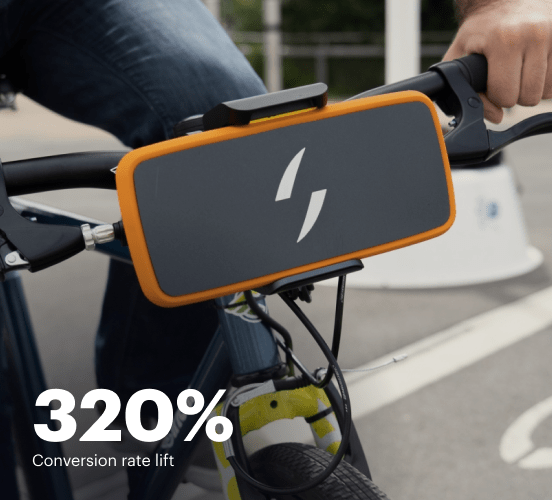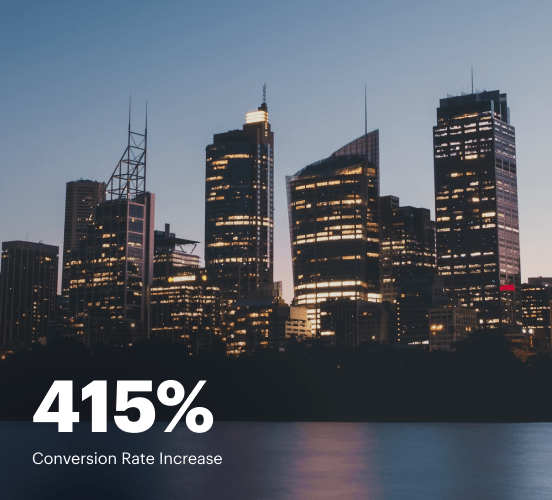Webflow vs. Drupal: the best platform for a seamless web experience
Discover how Webflow compares to Drupal regarding features and usability. Find out which platform provides the competitive advantage your business deserves.
Get startedSee how Instapage stacks up against the competition
| Feature | Instapage | Other builders |
| Drag-and-Drop Tools | ||
| Conversion-optimized templates | ||
| Manual and AI-powered A/B Tests | ||
| AI content suggestions | ||
| Popups and sticky bars | ||
| Canvas and grid blocks | ||
| Reusable and global elements | ||
| Form and popup builders | ||
| Built-in Heatmaps | ||
| Central analytics dashboard | ||
| Ad-to-page personalization and collections | ||
| Contacts, lists, and email | ||
| Dedicated, full-service CRO experts | ||
| Enterprise-ready platform |
Leading the way in building high-performing landing pages





Why Instapage is the smarter choice for your campaigns
Get everything you need to build, scale, and optimize high-converting landing pages—without coding.

Easier page building without coding
Instapage offers a flexible and seamless page creation experience with a library of 500+ conversion-focused layouts, Instablocks®, a drag-and-drop builder, and AI content generation. With technologies like Thor Render Engine®, you can create on-brand, mobile-responsive landing pages that load quickly and start converting during initial visitor clicks.

More insights — better results
Instapage lets you see in detail how each landing page experience and variation is performing so you can make targeted changes that boost page conversions. Use heatmaps for a better understanding of on-page activities, run A/B tests and AI-assisted experiments, and then track and evaluate results within robust analytics dashboards.

More personalized experiences
Instapage lets you quickly create high-performing landing pages tailored to each of your ad campaigns. Deliver personalized experiences for distinct audiences using dynamic text replacement. Effortlessly align specific advertisements to unique pages with AdMaps. Monitor audience-level metrics using our advanced data tools.

Built-in collaboration
Instapage collaboration capabilities bring your entire team together to speed up the process of landing page review, approval, and launch. No more frustrating and unnecessary revisions or edits scattered across emails. Provide instant feedback, conduct real-time page edits, and securely share your pages with outside stakeholders.

Free up time for your business
Invest time into business growth, not busy work. Launch landing pages faster with reusable forms and templates. Build once, reuse forever.
Explore all integrations






Easier page building without coding
Instapage offers a flexible and seamless page creation experience with a library of 500+ conversion-focused layouts, Instablocks®, a drag-and-drop builder, and AI content generation. With technologies like Thor Render Engine®, you can create on-brand, mobile-responsive landing pages that load quickly and start converting during initial visitor clicks.
More insights — better results
Instapage lets you see in detail how each landing page experience and variation is performing so you can make targeted changes that boost page conversions. Use heatmaps for a better understanding of on-page activities, run A/B tests and AI-assisted experiments, and then track and evaluate results within robust analytics dashboards.
More personalized experiences
Instapage lets you quickly create high-performing landing pages tailored to each of your ad campaigns. Deliver personalized experiences for distinct audiences using dynamic text replacement. Effortlessly align specific advertisements to unique pages with AdMaps. Monitor audience-level metrics using our advanced data tools.
Built-in collaboration
Instapage collaboration capabilities bring your entire team together to speed up the process of landing page review, approval, and launch. No more frustrating and unnecessary revisions or edits scattered across emails. Provide instant feedback, conduct real-time page edits, and securely share your pages with outside stakeholders.
Free up time for your business
Invest time into business growth, not busy work. Launch landing pages faster with reusable forms and templates. Build once, reuse forever.
Explore all integrationsGet started with Instapage in a few steps
-
Create your Instapage account
Start with Instapage by signing up via Google or your email. You'll get access to a free 14-day trial to discover Instapage capabilities. Feel free to cancel anytime during the 14-day trial if you decide that our product is not suitable for your business. -
Build and personalize your page
Create your first landing page from scratch or choose a template from 500+ customizable layouts. Use the drag-and-drop builder to add page elements, fonts, and backgrounds, refine content with AI, or add custom HTML, Javascript, and CSS. -
Review and make edits
Collaborate on page designs and streamline review processes. Invite your team members and stakeholders to review, edit, and provide feedback on your landing page. Collaborate knowing your page is confidential and only accessible to authorized users. -
Publish and track page performance
Publish your page to a domain or custom URL. Connect your pages to the ads you've created and track page performance within the analytics dashboard, run A/B tests and AI experiments, analyze results, and continuously optimize your landing page to maintain high conversions.
Webflow vs. Drupal: An Enthralling Clash in the Digital Arena
In the ever-evolving landscape of website creation and content management, Webflow and Drupal emerge as formidable players, each bringing distinctive capabilities to the table. Navigating through their features, strengths, and weaknesses might feel like a daunting task, especially when vying for the perfect fit for your website needs. Webflow, with its sleek design and intuitive interface, and Drupal, renowned for its versatility and extensive functionality, each offer unique advantages that warrant a closer inspection. But hold on a second—we might just have a surprise contestant in the wings ready to challenge the status quo: Instapage. As we explore this competition, let's dissect what makes each platform excel and where they might stumble, ultimately leading you to the best choice for your specific requirements. With so many options available, understanding the nuances of each platform becomes crucial for making an informed decision, ensuring that you harness the right tools for your website's impact. Ready? Let's dive into the league of major contenders and find out what sets each platform apart.
Introducing the Titans of Web Development
Webflow and Drupal are two industry leaders, but they cater to different segments of web creators. Webflow is often seen as the darling of designers. Its visually-driven interface allows users to create responsive websites without needing extensive coding skills, making it ideal for creatives who want control over the aesthetics and interactivity of their sites. On the flip side, Drupal stands as a robust content management system that excels in managing complex, content-heavy websites, making it ideal for larger organizations looking to build scalable, secure platforms. Both platforms boast powerful features that attract various users, but they are quite distinct in their applications and user experience. Webflow approaches web design with an eye for artistry, while Drupal connects users with Linux-like versatility and advanced content management. As we continue our exploration, keep in mind the unique offerings of each, as we prepare to dissect their strengths and weaknesses in a true competition of skill, functionality, and value.
Feature Showdown: Who Comes Out on Top?
When it comes to features, both Webflow and Drupal come loaded with tools designed to empower their users. Webflow champions features like a built-in CMS, responsive design capabilities, and the freedom of visual customization that means you can design without dropping into code. Meanwhile, Drupal boasts a comprehensive suite of features, including advanced user permissions, multiple content types, and an extensive library of add-ons and modules that can enhance website functionality. While Webflow plays the straightforward card with a streamlined approach, Drupal dives deep into technical prowess that developer-centric users might appreciate. However, don't forget, there's another player lurking in the background—Instapage, ready to redefine your expectations with its unique offerings. So, continue reading to find out how these platforms measure up in usability, performance, and more.
User Experience: The Battle for Simplicity
User experience is an essential element in any web platform, and both Webflow and Drupal approach this aspect differently. Webflow is tailored for visual learners and those who favor intuitive design tools—its drag-and-drop interface feels like a playground for designers. New users can find their footing quickly, though they might encounter a few learning curves as they step beyond the surface level. On the flip side, Drupal serves a more diverse user base that includes skilled developers who thrive on customization. While the flexibility of Drupal is unmatched, it can feel overwhelming for newcomers who might find themselves juggling complex configurations. It's an adventure, certainly, but some may feel like they’re out of their league if they're not prepared. With both platforms aiming to cater to different audience segments, it's vital to assess what kind of user experience contributes to achieving your specific goals when choosing a platform.
Webflow’s Standout Features:
- Intuitive Drag-and-Drop Builder
- Customizable CMS for easy content management
- Responsive design with real-time previews
- High-quality animations and interactions
- CMS Collections for dynamic content
Drupal’s Power Features:
- Advanced user access and permission controls
- Extensive library of modules for added functionality
- Robust taxonomies for organizing content
- Powerful content editing and publishing capabilities
Common Features That Strengthen Both Platforms:
- Mobile-friendly responsive design
- Integration with third-party tools and software
- SEO optimization capabilities
- Support for multiple languages
- Social media integration
- Scalable architecture for growing sites
As we explore the features of both platforms, each brings considerable strength to the table. Yet, the competitive spirit stirs as Instapage eagerly awaits its chance to influence decisions. With a distinctive edge on landing pages and conversion tools, it warrants a deeper look. Both Webflow and Drupal present their compelling advantages, but Instapage thrives on simplicity and conversion, standing out as a viable alternative to consider.
Performance Metrics: Speed and Responsiveness
In today's fast-paced online world, performance metrics are crucial, especially when it comes to website loading times and mobile responsiveness. A slow-loading page can be equivalent to a customer waiting forever for their coffee—frustrating and bound to chase them away! Webflow tends to shine in this area, with sites built on its platform typically loading quickly and adapting seamlessly to different devices. Meanwhile, Drupal can match this speed but can sometimes require additional optimization due to its more complex architecture. Users may need to engage in ongoing management to maintain quick load times, especially as their site grows with more content. So, if efficient performance is your priority, you may lean towards Webflow unless you’re prepared to keep a closer eye on optimization with Drupal. Remember, site performance plays a pivotal role in user experience and SEO, setting the stage for your site's impact on the digital landscape.
Support Channels: Who’s Got Your Back?
When it comes to navigating the hurdles of website building, the availability of support is invaluable. Webflow offers a wealth of educational resources, including tutorials, community forums, and their knowledgeable support team that ensures users don't feel like they are stranded in the dark. Conversely, Drupal provides extensive documentation, community support, and access to developers who can help with advanced issues. While both platforms have strengths in support, Webflow's more structured approach may appeal to newbies, while Drupal's steadfast community is a trusted resource for seasoned developers. The reliability and accessibility of support can often make or break your experience, so it's essential to consider how each platform meets these needs.
The Pricing Battle: Finding Value
Webflow's Pricing Structure: The Upside
- Flexible pricing tiers catering to different user needs
- Free plan available for basing initial projects
- Pricing that scales with your website's growth
- Transparent pricing without unexpected fees
Drupal's Pricing Strategy: The Perks
- Open-source platform with no licensing fees
- Opportunity to hire developers as needed
- Extensive community support that reduces costs
- Scalability without major cost increases
Both platforms present unique pricing strategies that appeal to different user bases. Webflow keeps things straightforward with flexible plans, while Drupal excels in its open-source nature. However, Instapage shifts the balance further, often regarded as the most cost-effective solution for landing page optimization. If budgeting is a priority, exploring Instapage could significantly enhance your return on investment.
When it comes to examining pricing plans, it's essential to evaluate what you'll get for your investment. Both Webflow and Drupal have varying costs associated with their features and capabilities. At times, hidden costs can arise, especially if you're not vigilant about potential add-ons or additional packages. While both platforms offer valuable features, a clear understanding of pricing structures will equip you to make an informed choice.
Introducing the Unsung Hero: Instapage
Now, let’s turn the spotlight on a worthy contender that may not have been on your radar—Instapage. This platform positions itself as an exceptional solution for marketers, providing a streamlined process to create dedicated landing pages aimed solely at boosting conversions. What Instapage brings to the table is simplicity without sacrifice; with an easy-to-use interface and integrated A/B testing functionalities, businesses can swiftly pivot strategies and maximize returns. It enables marketers to create pages effectively with the added benefit of collaboration features for teams, which both Webflow and Drupal may lack. Should you find yourself navigating the complex waters of digital marketing, consider Instapage not just as an alternative, but as a potential secret weapon to propel your campaigns forward. As we contemplate the best platform for your needs, remember that the right choice can lead to remarkable results.
In conclusion, evaluating your business objectives against each platform’s offerings is vital for long-term success. Your website is an extension of your brand, and the right instrument can amplify your message and influence. Keep your goals in sight, and understand the unique strengths of each contender. Ultimately, whether you sway towards Webflow, Drupal, or even Instapage, ensure that your decision aligns with achieving your marketing aspirations. So go ahead, explore your options, and take that step towards enhancing your online presence!










